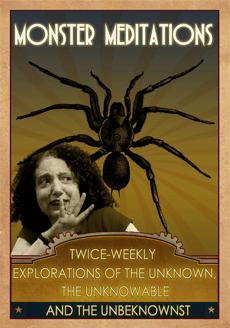The adage ‘show, don’t tell’ can only take a storyteller so far. Sometimes the best adventures take place INSIDE a character’s head. Internal monologues are an interesting tool in a fiction writer’s bag of tricks.
In a novel or short story, an internal monologue can be the voice of the story. This is often a good idea for a mystery as the reader is invited to go along with the detective as he or she interviews witnesses & suspects, checks in with the medical examiner, looks for clues at the crime scene, and fits the puzzle pieces into a picture of how the crime took place. This kind of first person approach is a classic option for police procedurals.
Of course, this narrow perspective can be a great double cross, as the reader usually assumes that the detective is reliable—and the unreliable (devious or misled) narrator is a wonderful, if slippery, voice for a story! There’s always the Roshomon gambit (referring to the 1950 Kurosawa classic film) where the story is told and retold from a variety of perspectives with entirely different narratives.
What was he thinking when the door opened suddenly? Was he frightened? That can be shown, so why say it? But if the door crashing open sends him into a flashback from a traumatic experience in his past, the writer has to go inside his head.
How did she feel when she realized her lover was the killer? Does she feel ashamed, betrayed, and used? You can probably communicate that with a description of her facial expression, a tear, a choked back cry, but if she’s harboring a secret respect for his criminal actions or if she’s already plotting revenge, the writer will likely talk to the reader about her complicated response.
There are lots of valid reasons to go inside the character’s head and reveal thoughts and feelings. Sometimes it’s an opportunity to flesh out a character’s backstory…
Why was she so sure the witness was lying? Was it because he reminded her of a liar she knew well? Or was she adept at reading micro expressions, after having spent years as an interrogator?
And sometimes it forwards the plot…
As soon as she realized the witness was lying, she knew what she had to do next. She told her partner they’d need their bulletproof vests and they headed back to…
In my experience, both as a reader and as a storyteller, long internal monologues slow the narrative down. But a quick sentence or two of inside information can increase the speed of the story, while bringing the reader insights they won’t get from the outside perspective.






Yes, yes, yes!!! I wish the omnipotent ‘they’ would re-write this adage to be ‘show what needs to be shown’.
lol – I’ve actually read a few stories in which the author was trying to show /everything/, including all the incidental stuff that really wasn’t needed.
All that showing actually slowed the story down and left me wishing the author would just get on with it.
I know ‘Show and Tell’ is supposed to be good advice, especially for inexperienced writers, but I’m feeling heretical today so I’ll say I think it’s just as likely to be misused as the good old ‘tell’.
Craft is as much about the rules a writer ignores as the ones she follows.
Maybe we need T-shirts that say: GOOD WRITERS SHOW WHAT NEEDS TO BE SHOWN——and tell the rest! LOL….
It’s true that showing a facial expression or another physical manifestation of an emotion works. … He threw his gym bag onto the table, knocking her delicate ceramic bowl to the floor where it shattered. He didn’t cry until he was on the floor to find a grape that had rolled under the sofa. Now, he realized that she wasn’t coming back…
A combination of SHOW and TELL creates drama quickly. I think that’s where the craft/rule/rule-breaking lives!